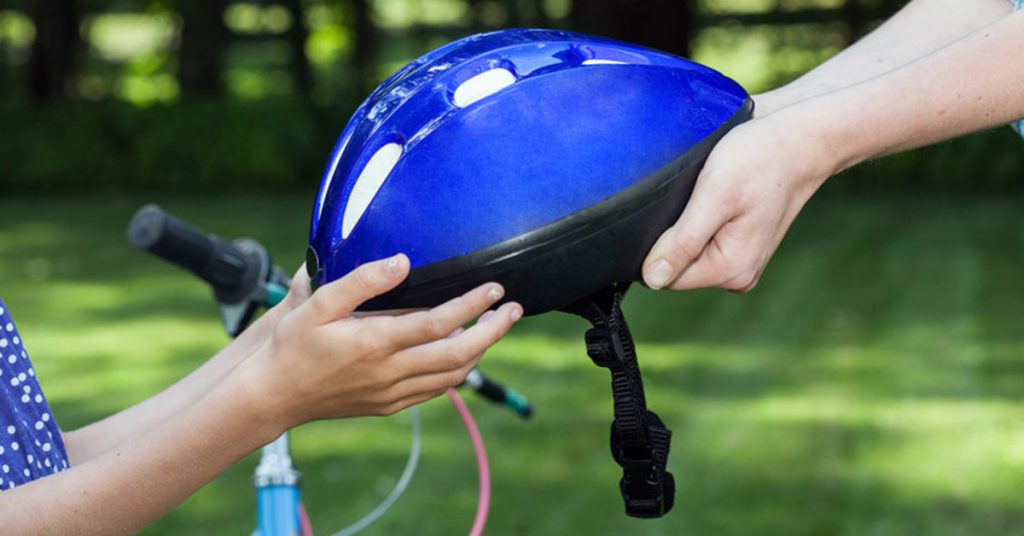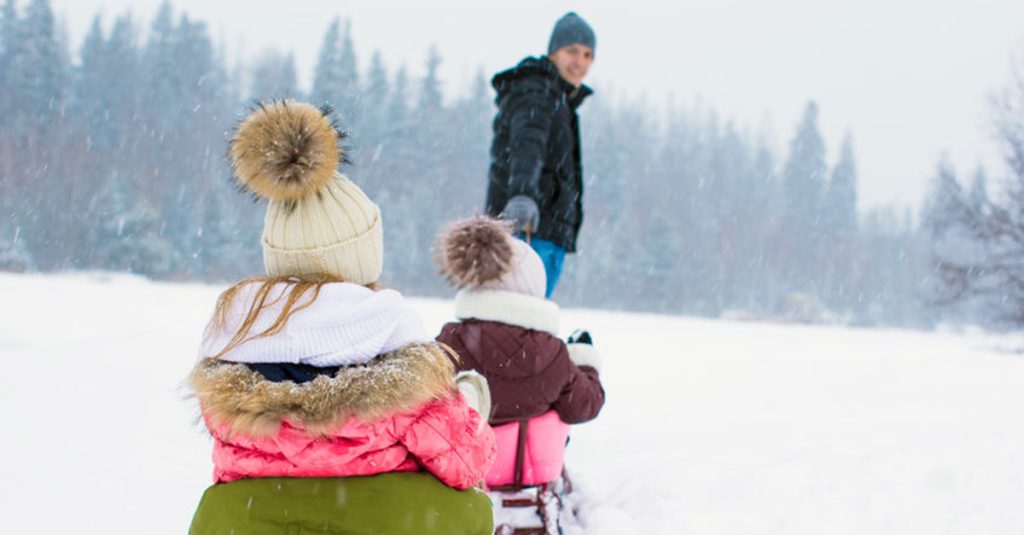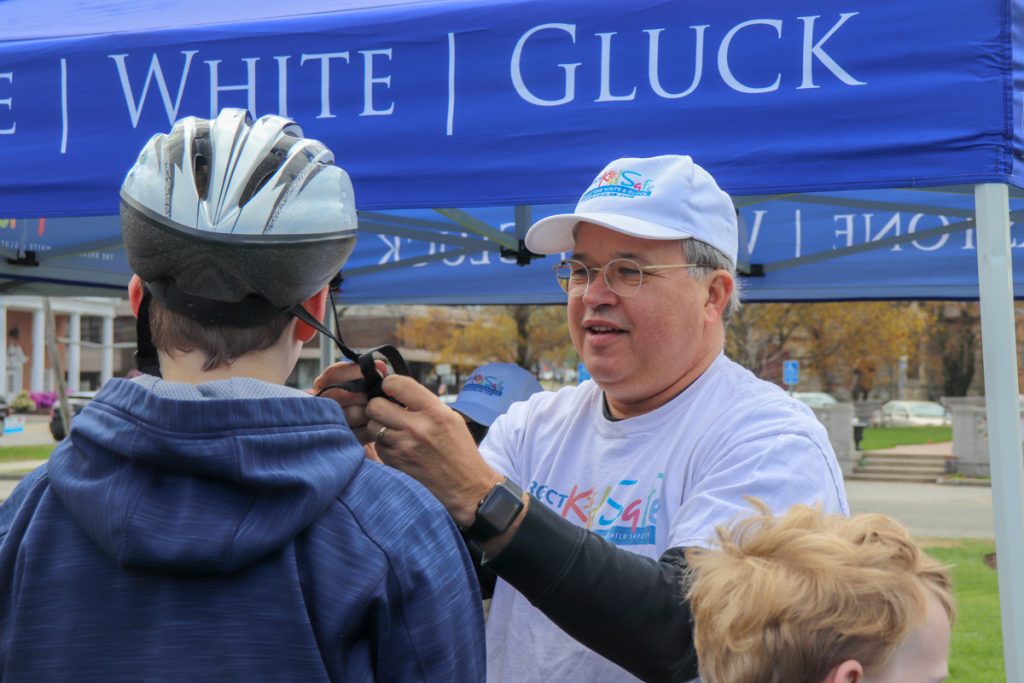Posts Tagged ‘“head injuries”’
Helping Children Remember Bicycle Helmets During Back to School
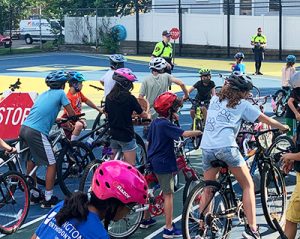
On your mark, get set, go! Breakstone, White & Gluck was pleased to donate bicycle helmets for children at the Arlington Police Department’s Bicycle Safety Day.
For many children, back to school means back to the school bus. But more and more, many students are walking or biking to school.
Back to school is a good time to introduce children to bicycle safety and this year, Breakstone, White & Gluck was pleased to partner with the Waltham and Arlington police departments to give helmets to children.
On Saturday, August 28th, the Waltham Police Department gave away free Project KidSafe helmets to children at the “Meet the New Chief Day.” The Arlington Police Department also gave away free helmets at Bicycle Safety Day on August 24th at Gibbs Junior High School, where many students walk or bike each day to class.
Our Tips to Help Children Wear Bicycle Helmets Back to School This Fall in Massachusetts
A new school year means a new routine. Whether you or your child ride daily or on occasion, we urge you to commit to wearing a helmet.
According to the National Highway Traffic Safety Administration, wearing a properly fitted helmet is the “single most effective way” to reduce head injuries and fatalities resulting from bicycle crashes. The Insurance Institute for Highway Safety reports the majority of cyclists who ultimately die after a bike crash first sustained a head injury as their most significant injury.
Children Must Wear Bicycle Helmets Under Massachusetts Law. Under Massachusetts law, cyclists who are 16 and younger are required to wear helmets when riding a bicycle. Helmets should be properly fitted and meet the safety standards set by the Consumer Product Safety Commission.
Beyond safety, there are other consequences. A police officer can actually impound your child’s bike for up to 15 days if they are caught riding without a helmet in Massachusetts, though many officers work hard to avoid this step and would rather encourage helmet use.
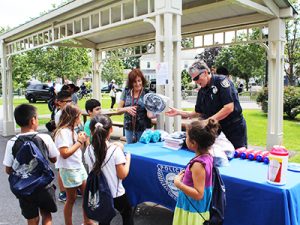
Waltham police officers give away free bicycle helmets at the “Meet the New Chief” event in August.
Why Parents and Adult Cyclists Should Wear Helmets. Cyclists of all ages should wear helmets to protect themselves.
As a parent, if you wear a helmet and make sure your child wears one when you ride together, your child will take notice. They are more likely to wear a helmet even when you are not there and they will have some practice at fastening their own helmet.
Label Your Child’s Helmet. Write your child’s name inside the helmet, on the strap or on the outside of the helmet.
Wear Your Helmet; Do Not Carry It In Your Backpack. Many children (and adults) ride, then put their helmets in their backpack while they are at work or school. Encourage your child to keep their helmet outside their backpack so they put it right on.
Buy a Durable Bike Lock. Purchase a durable bike lock in case your child cannot find their helmet and has to walk or get a ride home from school or a friend’s house. Keep this on their bike at all times. Insist that your child should contact you and never ride without a helmet.
Buy Your Child a Spare Bike Helmet. Purchase your child an extra bicycle helmet now before they misplace theirs. Unless you live near a bike shop, it can be difficult to step away from your routine to go purchase a bike helmet right away, especially during the busy Fall season.
At the same time, purchase a spare helmet for yourself, too. Keep your spare at home or at the office. This will come in handy if you damage your helmet, lose it or decide you want to take the Blue Bikes bikeshare home.
Free Legal Consultation – Boston Personal Injury Attorneys
With more than 100 years combined experience, Breakstone, White & Gluck has been consistently recognized as a top-rated Boston personal injury law firm. Our attorneys specialize in representing those injured by negligent driving, bicycle accidents, premises liability accidents, defective and unsafe products, construction accidents, medical malpractice and wrongful death.
If you have been injured, learn your rights. For a free legal consultation, contact Breakstone, White & Gluck at 800-379-1244 or 617-723-7676 or use our contact form.
Tips for Sledding Safely in Massachusetts
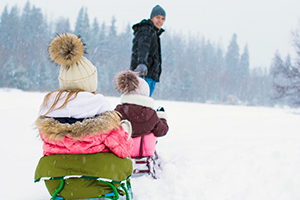 February has delivered perfect sledding weather for Massachusetts families. But before you head out with your children, remember the risk for injuries can rise during outdoor winter activities. Sledding, skating and skiing push our bodies beyond our daily routines as we face the elements of cold weather, snow and ice.
February has delivered perfect sledding weather for Massachusetts families. But before you head out with your children, remember the risk for injuries can rise during outdoor winter activities. Sledding, skating and skiing push our bodies beyond our daily routines as we face the elements of cold weather, snow and ice.
More than 20,000 children are treated for sledding injuries on average each year, according to the National Safety Council. Children can be injured when a sled hits a stationary object, in collisions with other sledders or by flipping or falling off their sled. Sledding accidents such as these can result in broken bones, lacerations, bruises, concussions, head injuries or more serious injuries.
You can protect your children by sledding with them and teaching them safety fundamentals by example. Please read our tips and enjoy a fun and safe sledding experience:
Choose a Safe Sledding Spot
After asking friends for suggestions and searching online, visit a few local sledding hills on your own, without your children. Walk to the top of the sledding area. Check your cell phone service from that point. Sledding hills may look similar, but they are not all equal. Choose a sledding area that is free from trees or rocks that could cause your child injury. Avoid hills that are too close to streets and parking lots.
Look for sledding hills that are snow-covered, not ice-covered.
A walkthrough is particularly useful for parents of young children, who are most vulnerable to the cold. Time your walk and compare this to your child’s regular play time in the snow and their physical capabilities. Think about whether your child can the hill – both the steepness for sledding and walking up the hill.
Sled During The Day. There is less visibility and colder temperatures at night. Your best approach is to sled during the day, when the sun is out.
Sled With Your Children and Supervise.
Sled as a Family. Plan at least one sledding day for your family each year. Besides being a lot of fun, this will create special memories. Sledding is also great way to get some fresh air and exercise for children, which we all need during the winter months.
Sled with Your Child and Their Friends. If your child or teenager wants to sled with friends, go along and watch. Enjoy this time but consider it a parenting assignment. You should really watch them just as you would if they were swimming, with your full attention. Keep your cell phone and a first aid kit within reach.
Sledding Manners. Teach your children to use good manners on the sledding hill. Even if there are no formal rules posted, your children should walk up the hill along the side of the sledding area. When sledding, they should not overcrowd sledders or attempt to run into them on the course. Once they reach the bottom of the hill, children should step off their sled.
—
Dress Warmly
When children are having fun, they may not realize how cold they are or be able to tell you.
Before you sled, make sure your child is wearing a warm winter coat, snow pants, hats, gloves or mittens. Purchase waterproof clothing. Your child should be warm and clothes should fit comfortably.
Take scarves off children before sledding. Also remove strings from clothing and accessories which can cause strangulation or get caught while your child sledding.
—
Safe Sleds and Helmets
Wear a Helmet. Encourage children to be aware of their surroundings and stay in control of their sleds as a good starting point to safety. Parents should also buy young children helmets to protect against head injuries. The Consumer Product Safety Commission advises parents can purchase helmets which meet the ASTM F14922 or Snell N-942 safety standard. If you have questions, we suggest you check the CPSC website which offers guidance on helmet designs for different activities. Another resource is your pediatrician. Ask for their specific suggestion for protecting your child.
Check Your Sleds. If you see sharp edges or cracks, replace your child’s sled.
Purchase a Safe Sled. There are many types of sleds: snow tubes, saucers or toboggans. Read age recommendations and product safety labels. Look for sleds which can be steered or have handles. Specifically look for ropes. While many sleds come with ropes, you can purchase sleds without any to protect young children against strangulation or getting caught on something.
Before you purchase a sled, make sure to check the Consumer Product Safety Commission website for safety recalls. Sleds can be designed with defects, such as faulty brakes on higher end models.
No Make-Shift Sleds. Do not allow your child to make their own sled out of furniture, cardboard or household objects. These products are not designed to carry your children on the snow.
—
Safe Sledding Techniques
Sledding Techniques. Pull your sled up next to theirs and show your children how to ride their sleds safely. Children should generally sit, hold the handles and ride face-forward down the hill. They should not ride stomach down or face first because they could flip or fall off. This can cause serious head or spinal cord injuries.
Riding Alone or Together? It’s a lot of fun to sled with your children or watch them ride together. The key is to find the right sled for the right number of sledders. And of course, the right hill!
Adults can pull young children. But for the most part, children should sled alone as they get older. It is important for them to steer their own sleds and hold on for themselves.
If you want to purchase a sled or tube that carries more than one child or adult, that’s a special experience. Read the manufacturer’s age recommendations, safety warnings and instructions. Look for a few online videos.
Free Legal Consultation – Boston Personal Injury Lawyers
Breakstone, White & Gluck is pleased to share our sledding tips as part of our Project KidSafe campaign. Through Project KidSafe, our goal is to help families protect against child injuries.
Breakstone, White & Gluck is a top-rated Boston personal injury law firm, with more than 100 years combined experience. We represent clients in personal injury cases in Boston and across Massachusetts. If you have been injured by someone else’s negligence, contact us for a free legal consultation at 800-379-1244 or 617-723-7676 or use our contact form.
How to Fit a Bicycle Helmet
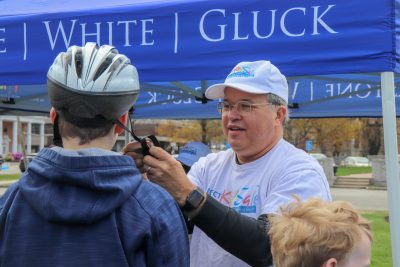
Attorney David W. White fitting helmets at Framingham Earth Day 2019. Part of Breakstone, White & Gluck’s Project KidSafe campaign to prevent head injuries.
While many people enjoy cycling, very few enjoy the process of selecting and fitting a bicycle helmet. The challenge is even greater for parents who have to find helmets for their children.
Breakstone, White & Gluck launched our Project KidSafe campaign in 2013 to help children and families, along with other cyclists, overcome some of the challenges. Read some of our tips for getting started with a bicycle helmet which fits and protects:
- Before you shop, find a flexible tape measure and measure around your head. Measure from about an inch above your eyebrows.
- Rather than shopping online, try to purchase a helmet at a local bicycle shop. Ask the staff to help you fit it properly.
- Before you purchase, ask if the helmet meets the safety standards set by the Consumer Product Safety Commission.
- Don’t share bicycle helmets. Each cyclist should have their own helmet.
- Store your helmet inside and avoid exposing it to heat in sunlight unless you are wearing it. Don’t leave it in your car for any extended period.
- Replace bicycle helmets when they become worn or if you or your child outgrow yours. You may want to consider buying a new helmet every three years. From the outside, your helmet may appear to be in good condition. Yet the protective material inside can deteriorate without any visible signs.
- Immediately replace bicycle helmets which hit the ground in a bicycle accident or fall.
- Carry your bicycle helmet if you want to use a bikeshare. Make it a rule not to rent a bike without a helmet.
- Plan ahead: Keep an extra bicycle helmet at work or at home.
- Remember, parents who wear helmets encourage children to wear helmets.
- Take children to bicycle safety events in the community to encourage their interest in cycling and safety.
About Breakstone, White & Gluck
Breakstone, White & Gluck is a Boston personal injury law firm which represents those injured by the negligence and wrongdoing of others across Massachusetts. After more than two decades of representing cyclists who have been injured, the firm’s partners launched the Project KidSafe campaign to help prevent injuries on bikes and encourage children to wear helmets throughout their lives. The firm specializes in all areas of personal injury law.
Learn more about our attorneys.
Learn more about the Project KidSafe campaign.
Watch a video demonstrating how to fit a bicycle helmet.
Breakstone, White & Gluck Donates 100 Bicycle Helmets to The Home for Little Wanderers
With a donation from Breakstone, White & Gluck’s Project KidSafe campaign, children at The Home for Little Wanderers are ready for safe riding.
We made a special donation of 100 bicycle helmets to The Home this week, for children and young adults in The Home’s residential and special education programs in Roxbury Crossing, Plymouth and Walpole. The Home serves children and young adults who need family support because of abuse, neglect or other reasons. For more than 200 years, it has filled a critical need in the Boston area, keeping children safe and helping them transition into foster care, adoption or independent living as adults. The Home provides the basic necessities of food, shelter and clothing for children, as well as mental health services, counseling, special education and many other services.
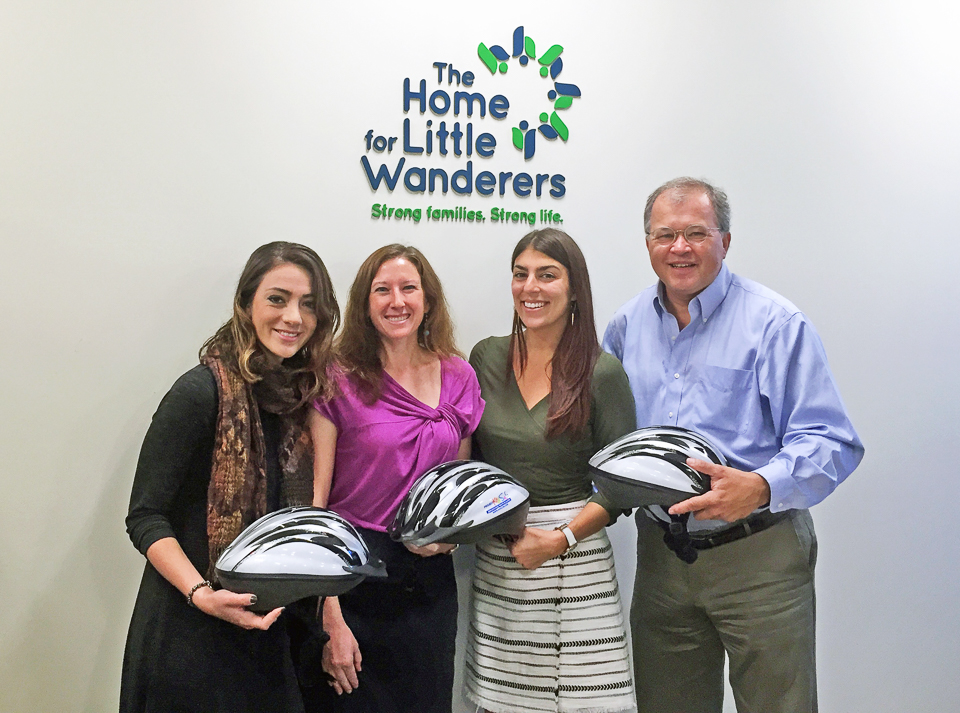
Photo: Attorney David White stopped at The Home for Little Wanderers this week and delivered bicycle helmets from Breakstone, White & Gluck’s Project KidSafe campaign. He was greeted by (left) Paige Oldaker, Leadership Gifts Officer; Johanna Lauer, Volunteer Mentor; and Taryn Marino, Manager of Volunteer and Mentor Programs. (next to David).
Breakstone, White & Gluck is committed to keeping children safe through our Project KidSafe campaign. Since 2013, our law firm has donated over 10,000 bicycle helmets to children who need one in Massachusetts. Our goal is to encourage children to wear bicycle helmets every time they ride to prevent serious head injuries in bicycle accidents or falls.
We learned about The Home’s need for new helmets from a volunteer. She told us children at The Harrington House in Roxbury Crossing were wearing old and worn-down helmets. Then we learned about the need at the other programs and were told the children and young adults love to ride bikes. We saw an opportunity to help.
“We were very pleased to make this donation, especially since the children really enjoy riding bikes,” Attorney David White said. “The Home for Little Wanderers is a lifeline for many children who have been neglected or abused in Massachusetts. While receiving services, the children should have the opportunity to ride bicycles, play and just be kids for a few minutes each day. We hope with brand-new bicycle helmets, they can ride safely and have a little fun.”
Head Injury Guidelines Begin for Student-Athletes This Fall
 Student-athletes in Massachusetts will add a new drill to their warm ups this fall: concussion training aimed at preventing deaths, long-term injuries and disabilities.
Student-athletes in Massachusetts will add a new drill to their warm ups this fall: concussion training aimed at preventing deaths, long-term injuries and disabilities.
In 2010, the state Legislature passed a law requiring training and education for anyone involved in public middle school and high school sports. The Department of Public Health issued guidelines in June detailing the requirements, which include:
- Parents, players, coaches, school nurses, volunteers and others involved in sports must participate in annual state-approved training on how to recognize the symptoms of concussions.
- Schools have a few options for fulfilling the training requirement, including offering training materials at parent meetings and online trainings from the Centers for Disease Control and Prevention and the National Federation of State High School Associations.
- Student-athletes who suffer a head injury must be immediately removed from play and get medical clearance before returning.
- Student-athletes diagnosed with a concussion must have a written plan for returning to the game and the classroom.
- Student-athletes with a history of head injuries must file an injury report before every season.
Across the country, an estimated 136,000 student-athletes suffer concussions in high school sports each year.
Concussions are often referred to as a “metabolic cascade,” a series of changes in which the brain’s nerve cells stop functioning properly and blood flow slows down.
Concussions can occur when athletes collide with other players, equipment or the ground. It is important for people who suffer concussions to reduce physical and cognitive activity. When there is a subsequent injury, concussions can be fatal and result in long term injuries impacting memory, mood and impulses.
Concussions can be difficult to diagnose in part because the effects are not visible on imaging tools such as CT scans or MRIs.
Massachusetts schools are making changes as awareness about concussions increases throughout the sports and medical community. Starting this fall, Ivy League football players are limited to suiting up for two full-contact practices each week. The pending contract agreement will implement new guidelines for National Football League (NFL) players as well.
For more information, click to read this article in The Boston Globe.
Read More
Helmets Protect Bicyclists of All Ages
 Bay State Bike Week is a good time to remember safety for Massachusetts bicyclists, motorists and all who travel the roads.
Bay State Bike Week is a good time to remember safety for Massachusetts bicyclists, motorists and all who travel the roads.
Motorists can commit to being vigilant in looking out for bicyclists this summer and slowing down. Bicyclists can ask whether they have taken all possible safety precautions.
These safety precautions must include bicycle helmets. Bicycle helmets are 85- to 88-percent effective in mitigating head and brain injuries in bike crashes, according to the National Highway Traffic and Safety Administration (NHTSA).
Nearly 70 percent of all fatal bike crashes involve head injuries, according to NHTSA figures. But only about 20 to 25 percent of all bicyclists wear helmets.
Individual states govern whether bicyclists must wear helmets. California was the first state to pass a bicycle helmet law in 1986. Twenty five years later, 21 other states have adopted laws aimed at cyclists under age 16. Fourteen states have no helmet laws, though the NHTSA recommends states adopt legislation.
Massachusetts requires helmets be worn by those 16 and younger while operating a bicycle or traveling on one as a passenger. Helmets must be approved by the Consumer Product Safety Commission.
Adults in Massachusetts and other states should not wait for the law to require them to wear helmets. In 2006, 773 bicyclists were killed and another 44,000 were injured in traffic crashes across the country. Children 14 and younger accounted for 98 of those fatalities, making this one of the most frequent causes of injury related death for young children. But the other 675 bicyclists were older and many of them could have also benefited from the protection of a bicycle helmet.
Click here for more information about bicycle helmet laws from the National Highway Traffic Safety Administration.
Read More


